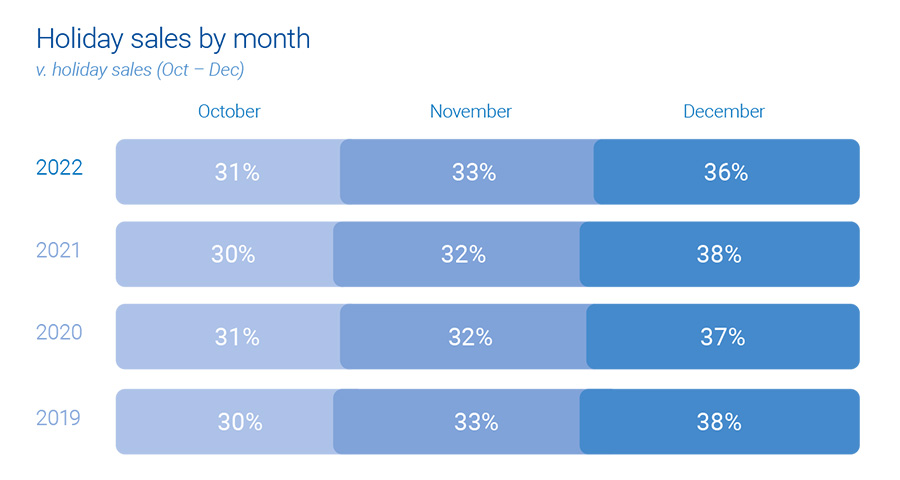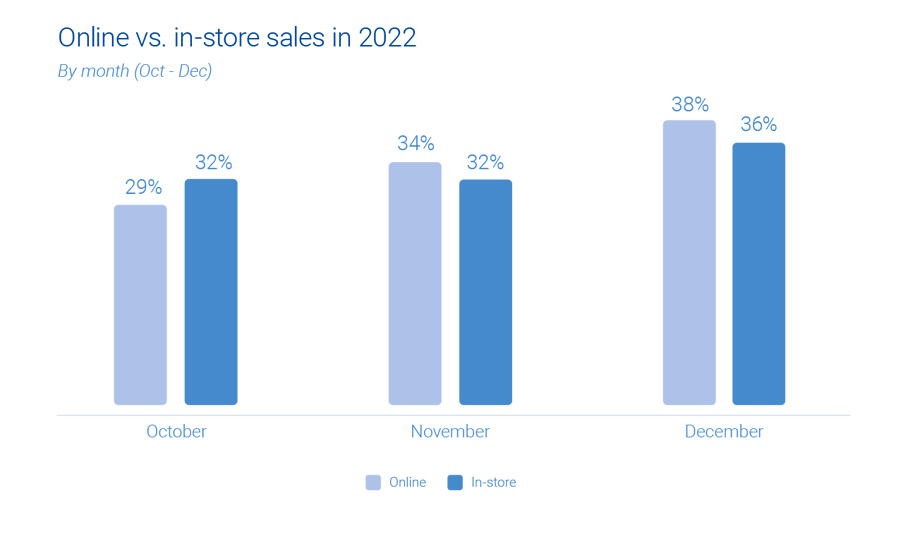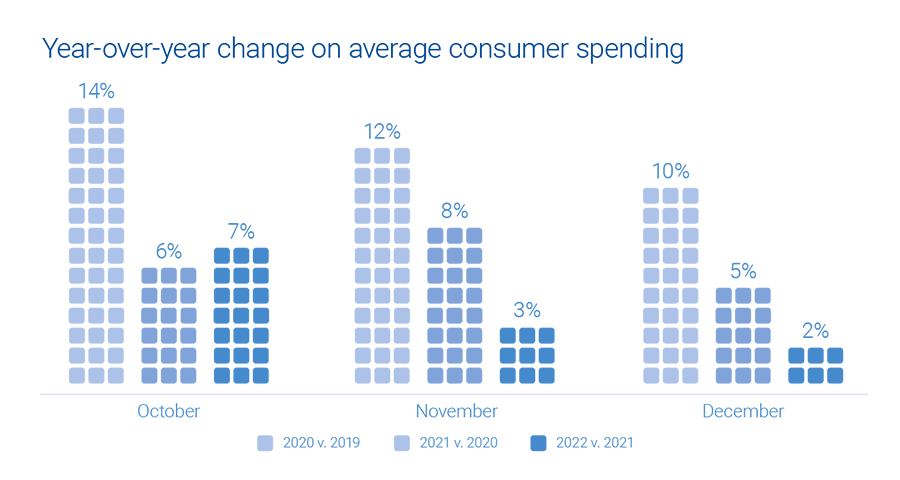
The holiday season is just around the corner, and retailers and marketers are gearing up for the busiest shopping period of the year. It’s crucial to understand how consumer behavior is evolving and what emerging trends to expect. Experian’s 2023 Holiday spending trends and insights report analyzes recent trends, consumer spending habits, and anticipates what’s to come in 2023 to help you deliver a top-notch shopping experience this holiday season.
In this blog post, we’ll cover three key insights from our report.
1. Consumers are shopping earlier
It’s no secret that December has always been the go-to month for consumers when it comes to holiday spending. However, holiday shopping now starts earlier, particularly with online sales.

This can be attributed to a surge in promotions and deals, enticing shoppers to open their wallets ahead of time, giving a significant boost to holiday sales. Notably, Cyber Week sales have proven to be an influential factor, accounting for 8% of total consumer holiday spending.
Experian tip
Reach the right shoppers with your promotions with sell-side targeting. This powerful approach gives you control over where your ads are placed while ensuring maximum visibility through direct connections with publishers. Whether on mobile, web, or CTV, this seamless ad experience will engage your audience effectively.
2. Online sales are on the rise
The popularity of online holiday sales is continuously growing, surpassing in-store shopping. There has been a consistent 1% year-over-year increase in online sales, while in-store sales have seen a 1% decrease.
“It’s easier for consumers to comparison shop for large ticket items online that they might find at a mass retailer or office supply store. Consumers prefer to have larger, bulkier items shipped directly to their home for minimal cost. By shopping online, consumers can save time since they don’t need to wait in checkout lines.”
Anna Liparoto, Sr. Account Executive, Retail & CPG

Although online sales currently make up only one-third of all holiday shopping, there is immense potential for further expansion. Mass retailers and office, electronics, and games industries particularly excel in online holiday sales. While in-store purchases remain the primary choice for holiday shoppers, consumer online and offline activities intersect before the final purchase.
Experian tip
Take advantage of the surge in online shopping by diversifying your marketing channels. An agnostic identity graph can bring together device and media data, capturing valuable user insights. By gaining a holistic view of your target audience, you’ll be able to optimize your ad spend and allocate resources effectively, ultimately boosting your return on investment.
“Omnichannel targeting during the upcoming holiday season will continue to prove to be the best way to reach scale and maximize ROI across all marketing channels.”
Joe LigÉ, Head of Enterprise Demand Partnerships
3. 2023 holiday spending will be on par with 2022
During the holiday season in 2022, consumer spending showed an anticipated increase, although the growth rate was slightly lower compared to previous years. October saw a surge in average consumer spending, indicating a swift response to early discounts and promotions offered by retailers.

As the holiday season progressed, holiday spending gradually slowed down and reached a level similar to that of the previous year. Overall, there was a modest 2% growth. Looking into the future, if economic conditions remain stable in the second half of 2023, we can expect holiday spending to align with the figures from last year.
Experian tip
To truly maximize impact, consider data enrichment. By diving deeper into your target audience’s preferences and behaviors, you can better tailor your strategies and seamlessly integrate the enriched data across various channels. This allows you to unlock the true potential of your ad inventory, creating more meaningful connections with your audience.
Download our 2024 report
Get ready for the holiday shopping season with Experian’s 2024 Holiday spending trends and insights report. Inside you’ll find:
- Analysis of past trends and what they mean for 2024
- Exclusive predictions for the upcoming holiday season
- The top audiences to activate this holiday season
To access to all of our predictions for this year’s holiday shopping season, download our 2024 Holiday spending trends and insights report today.
Latest posts

Published in AdExchanger. “Data-Driven Thinking" is written by members of the media community and contains fresh ideas on the digital revolution in media. Today’s column is written by Tom Manvydas, vice president of advertising strategy and solutions at Experian Marketing Services. The proliferation of connected electronics has spurred new interest in device-recognition technologies even though they have been in use since the 1990s. As we enter the “Internet of Things” era, device recognition will significantly impact the ad tech ecosystem. Many network advertising technologies are becoming obsolete as cookie blocking grows and the Internet becomes more mobile and device-centric. Device recognition will be yet another technology challenge for marketers but has the potential to overcome many key tracking, measurement and privacy issues with which data-driven marketers have struggled. By leveraging device recognition technologies, marketers can protect their investments in Web 2.0 ad tech, like multitouch attribution, and improve their overall digital marketing programs. Device Recognition Vs. Cookies Device recognition attempts to assign uniqueness to connected devices. By focusing on the device, you are able to “bridge” between browsers and apps, desktop to mobile and across OS platforms like iOS and Android. Device-recognition IDs function like desktop cookies for devices but with four important differences: 1. Coverage: Device-recognition methods are largely immune from cookie limitations. About half of mobile engagements on the Web do not involve cookies, while third-party blocking impacts up to 40% of desktop engagements. 2. Persistency: Device-recognition IDs can be more persistent and less fragmented than most desktop cookies. For example, Apple’s UDID or Android ID are permanent, and network node IDs like MAC addresses are near-permanent. Proxy IDs such as IDFA are persistent but can be updated by the device owner or ID provider. 3. Uniqueness: Devices are unique and cookies are fragmented. The digital media industry incurs substantial overhead cost and loss of efficiency when dealing with fragmented profiles and obsolete data caused by cookie churn. However, device-recognition methods are limited in their ability to recognize multiple profiles on shared devices. 4. Universality: Device-recognition technologies are universal and generally work across devices and networks. However, interoperability issues across device operating systems, such as iOS and Android, can limit the universal concept. There are many types of device-recognition technologies but two basic approaches to device recognition: deterministic and probabilistic, each with their pros and cons. Deterministic Approach: Accurate And Persistent But Complicated Deterministic device recognition primarily uses the collection of various IDs. While the mobile developer is familiar with the variety of IDs, it’s important that marketers become better-versed in this area. Examples include hardware IDs (including serial numbers), software-based device IDs (such as Apple’s UDID or the Android ID), digital data packet postal codes or proxy IDs (such as MAC addresses for WiFi or Bluetooth, IDFA for both iOS and Android and open-source IDs). Deterministic methods improve the accuracy of tracking, targeting and measurement over current cookie-based methods. They can improve the ability to more persistently manage consumer opt-outs. But the proliferation of device types limits the universality of deterministic device recognition. Without uniform standards across platforms, marketers need to account for multiple ID types. Also, deterministic device-recognition methods are not well developed for desktop marketing applications. The lack of interoperability across deterministic device IDs makes execution too complicated. Deterministic device IDs were meant for well-intentioned uses, such as tracking the carrier billing for a device. However, they present privacy and data rights challenges, leading to blocking or limited access by companies that control IDs. Probabilistic Device Recognition: A ‘Goldilocks’ Solution Probabilistic device recognition may be the ideal solution for a connected world that does not rely on cookies nor wants to use overly intrusive deterministic device recognition. Probabilistic device recognition is not a replacement for deterministic IDs. Instead, it complements their function and provides coverage when they are not available. The probabilistic approach is based on a statistical probability of uniqueness for any single device profile. This approach creates a unique profile based on a large number of common parameters, such as screen resolution, device type and operating system. This process can uniquely identify a device profile with 60% to 90% accuracy, compared to 20% to 85% accuracy for cookie-based identification methods. Probabilistic IDs are more persistent than cookies with better coverage, but less persistent than deterministic device IDs. The natural evolution of the device takes place over time and prevents persistent identification. Probabilistic device recognition can be universal and is not impacted by interoperability issues across platforms — the technology used to generate a probabilistic ID on one network can be the same technology on another network. Unlike some deterministic device recognition approaches, there is no device fingerprinting. Probabilistic device recognition accurately identifies profiles in aggregate, rather than a single device. That’s the inherent beauty of probabilistic device recognition: It can generate more accurate targeting results than cookie-based methods without explicitly identifying single devices. This is more than good enough for most marketers and significantly better than what’s available today. Another benefit is the absence of any residue on the device — no cookie files, flash files or hidden markers. Probabilistic methods can work on devices that block third-party cookies or connect to the Web without using any cookies. For example, you might have a hard-to-reach but valuable audience segment. Probabilistic device recognition could effectively increase your reach on this segment by 40% to 50% and increase the overall targeting accuracy by two times. Let’s say the actual population for this segment is 100,000 members. The typical cookie-based approach might reach 28,000 members but the typical probabilistic device-recognition approach could reach 65,000 members. A Decline In Hardware Entropy If you take a close look at the emitted data from today’s devices, it is not easy to analyze it for device identification. That’s because the data footprint of one device looks a lot like another. Device recognition augmentation methods can address this, such as device usage profiles, geo location clustering, cross-device/screen analytics or ID linkage for first-party data owners. In the short term, device-recognition technologies, particularly probabilistic methods, can greatly improve today’s digital marketing programs. Marketers should become fluent in their use cases and benefits. If 2013 was the year of mobile, I think we’ll see a surge in marketing applications based on device-recognition technologies in 2014. Follow Experian Marketing Services (@ExperianMkt) and AdExchanger (@adexchanger) on Twitter.

According to Experian Marketing Services’ 2014 Digital Marketer: Benchmark and Trend Report, social media Websites are playing an increasingly important role in driving traffic to other Websites, including retail sites and even other social networking sites, at the expense of search engines and portal pages. For instance, as of March 2014, social media sites account for 7.72 percent of all traffic to retail Websites, up from 6.59 percent in March 2013. Further, Pinterest, more than Facebook or YouTube, is supplying the greatest percentage of downstream traffic to retail sites. According to the Digital Marketer Report, more retailers are directing their customers to social media within their email campaigns. In fact, 96 percent of marketers now promote social media in their emails, and it shows. In 2013, for instance, email Websites generated 18 percent more clicks to social networking pages than the year prior. Social drives more traffic to other social Websites Social media Websites are driving more and more traffic to other social sites. In 2013, 15.1 percent of clicks to social networking and forum sites came from other social networking sites, up from a 12.5 percent click share reported in 2012. Despite driving the greatest share of traffic to social networking sites with 39.1 percent of clicks, search engines’ share of upstream traffic to social declined a relative 13 percent year-over-year. Among the other top referring industries to social, only the portal front pages industry — which includes sites like Yahoo!, MSN and AOL and is closely affiliated with search engines — showed a drop in upstream click share providing further evidence that increasingly all (or most) roads lead to social. To learn more about key trends in social media traffic, including downstream traffic from social sites and the share of consumers accessing social media across multiple channels, download the free 2014 Digital Marketer: Benchmark and Trend Report.

Mother’s Day may not exactly be right around the corner, but the time to send your Mother’s Day emails sure is! Based on our analysis of 186 brands that sent Mother’s Day mailings in 2013, 75 percent of email volume and 80 percent of email-generated revenue occurred between May 1st and Mother’s Day (May 12, 2013). The highest revenue-producing days were five days before the holiday (Wednesday, May 8, 2013) and Mother’s Day itself. This year, the sentimental holiday falls one day sooner than last year (May 11), but you still have more than enough time consider these quick tips for easy wins while planning and executing your campaigns. Tip 1: Give them what they’re searching for Last year, online searches five weeks before Mother’s Day were dominated by searches for the date of the holiday. As such, we recommend including the date of Mother’s Day in your email subject lines, particularly those early in the season, when customers are searching online for, and opening emails with, that information. Tip 2: Set the tone early with your subject lines A sample of early season subject lines that outperformed the overall unique open rate included: Remember Mom on Mother’s Day, May 12 Get a head start on Mother’s Day (plus a gift for you) Just arrived: Mother’s Day Gift Sets To Mother, With Love Tip 3: When it comes to timing, it’s the thought that counts Think through the timing of your emails depending on order delivery deadlines. On May 8th of last year, the largest revenue producers for email were orders for flowers and gifts placed in time to be delivered by Mother’s Day. Email subject lines on May 8th included reminders of the delivery deadlines: Last Chance: Free Shipping/No Service Charge for Mother’s Day! ENDS TODAY: Enjoy Complimentary Second Day Delivery in Time for Mother’s Day Tip 4: Let them treat themselves On Mother’s Day, the top email revenue generators were “self-gifting” (treat yourself on Mother’s Day only), Mother’s Day online sales and free shipping, as well as e-gift cards: Free Shipping Today Only! Happy Mother’s Day You deserve a treat yourself! HAPPY MOTHER’S DAY! Treat yourself to 30% off today only Last Chance: eGift Cards in Time for Mother’s Day Other email performance highlights: Note: All email performance highlights are based on comparisons to Mother’s Day mailings without the highlighted feature from matched brands. To all those in the midst of Mother’s Day campaign planning, good luck and happy sending!